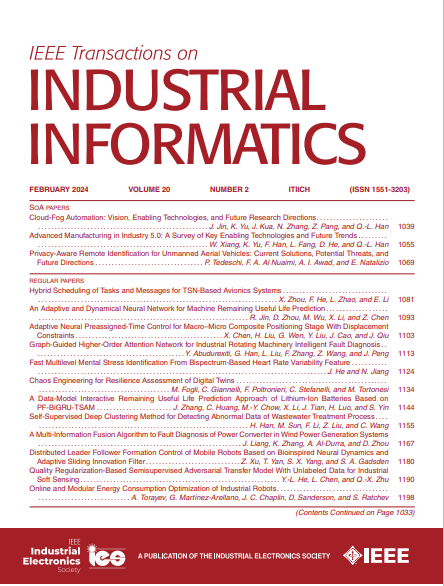Deep Spatial–Temporal Slow Feature Transfer Network for Multimode Chemical Process Soft Sensing on Imbalanced Data
IF 9.9
1区 计算机科学
Q1 AUTOMATION & CONTROL SYSTEMS
引用次数: 0
Abstract
For soft sensor modeling of multimode chemical processes, a common method is to build an individual model corresponding to each mode. However, certain individual mode models may not be reliable due to the imbalanced data across different modes. The soft sensor built for one mode with sufficient data exhibits suboptimal performance for other modes with insufficient data. To address this issue, a deep transfer learning method is introduced for soft sensor and a deep transfer spatial–temporal slow feature regression framework (STSFE) is proposed. In the framework, a Siamese network is employed for slow feature extraction. In addition, the encoder–decoder structure is embedded for input reconstruction verifying the effectiveness of slow features. However, the Siamese network fails to consider correlation of variables in quality prediction. To address this limitation, the Siamese network is designed with an embedded spatial–temporal attention mechanism to construct the STSFE model, and the spatial–temporal slow features are augmented with the historical quality variable for current quality prediction. The STSFE model is initially trained for the mode with sufficient data (source domain), and then transfer learning is employed to facilitate knowledge transfer from the source domain to the target domain (the mode with insufficient data) by reusing the lower level extraction part of STSFE. The effectiveness of the proposed method is validated through a benchmark sewage treatment case and a real chemical process.基于非平衡数据的多模式化工过程软测量的深度时空慢特征传递网络
对于多模态化学过程的软测量建模,一种常用的方法是为每个模态建立一个单独的模型。然而,由于不同模态之间的数据不平衡,某些单个模态模型可能不可靠。为数据充足的一种模式构建的软传感器在数据不足的其他模式下表现出次优性能。为了解决这一问题,引入了一种用于软传感器的深度迁移学习方法,并提出了一种深度迁移时空慢特征回归框架(STSFE)。在该框架中,采用Siamese网络进行慢速特征提取。此外,还嵌入了用于输入重构的编码器-解码器结构,验证了慢速特征的有效性。然而,Siamese网络在质量预测中没有考虑变量的相关性。为了解决这一问题,Siamese网络设计了嵌入时空注意机制来构建STSFE模型,并利用历史质量变量增强了时空缓慢特征,用于当前质量预测。首先针对数据充足的模式(源域)对STSFE模型进行训练,然后通过重用STSFE的低层提取部分,利用迁移学习实现知识从源领域向目标领域(数据不足的模式)的迁移。通过一个标杆污水处理案例和一个实际化工过程验证了该方法的有效性。
本文章由计算机程序翻译,如有差异,请以英文原文为准。
求助全文
约1分钟内获得全文
求助全文
来源期刊

IEEE Transactions on Industrial Informatics
工程技术-工程:工业
CiteScore
24.10
自引率
8.90%
发文量
1202
审稿时长
5.1 months
期刊介绍:
The IEEE Transactions on Industrial Informatics is a multidisciplinary journal dedicated to publishing technical papers that connect theory with practical applications of informatics in industrial settings. It focuses on the utilization of information in intelligent, distributed, and agile industrial automation and control systems. The scope includes topics such as knowledge-based and AI-enhanced automation, intelligent computer control systems, flexible and collaborative manufacturing, industrial informatics in software-defined vehicles and robotics, computer vision, industrial cyber-physical and industrial IoT systems, real-time and networked embedded systems, security in industrial processes, industrial communications, systems interoperability, and human-machine interaction.
 求助内容:
求助内容: 应助结果提醒方式:
应助结果提醒方式:


